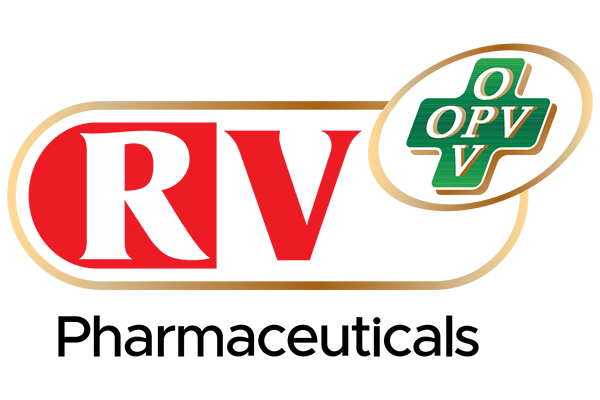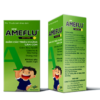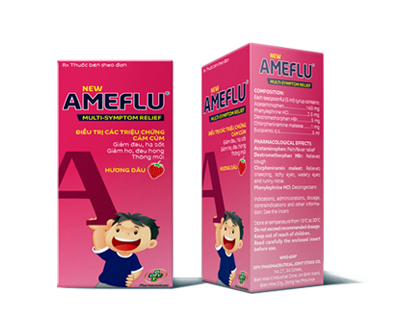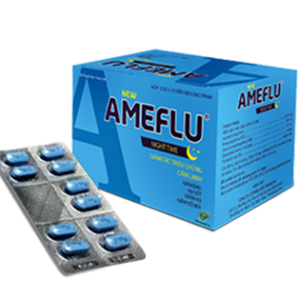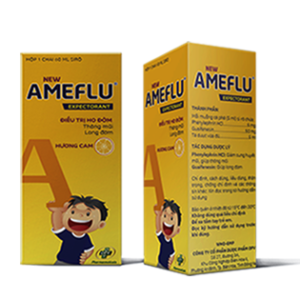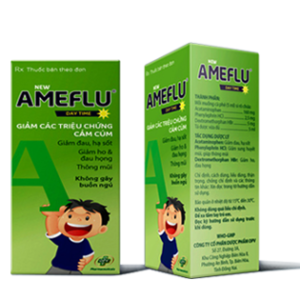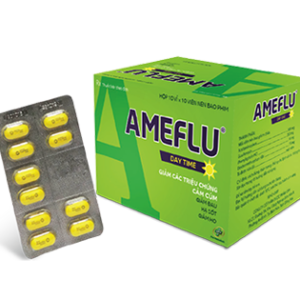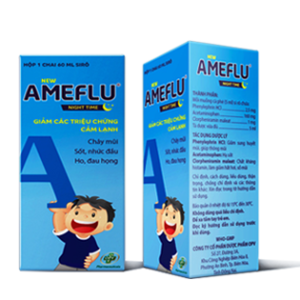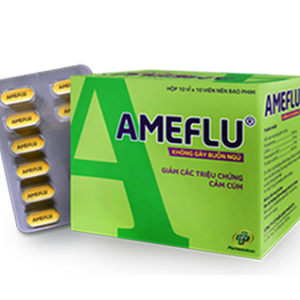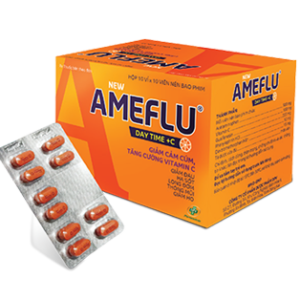COMPOSITION: Each 5 ml contains:
Active ingredients:
Acetaminophen….…………………160 mg
Phenylephrine HCl…………………2.5 mg
Dextromethorphan HBr……………5 mg
Chlorpheniramine maleate…………1 mg
Excipients: sodium benzoate, glycerin, sorbitol 70%, sucralose, citric acid, sunset yellow, polyethylene glycol 400, propylene glycol, strawberry flavor, Red No 40, purified water.
INDICATIONS:
- Temporarily relieves the common cold symptoms: Minor aches and pains, headache, sore throat, nasal congestion (stuffy), cough, sneezing and runny nose and fever.
DOSAGES AND ADMINISTRATIONS:
Children 6 – 11 years: Take 2 teaspoons (10 ml) every 4 hours. Do not take more than 10 teaspoons (50 ml) in 24 hours.
Children 4 – 5 years: directed by a doctor or Take 1 teaspoons (5 ml) every 4 hours. Do not take more than 5 teaspoons (25 ml) in 24 hours
Children under 4 years: directed by a doctor.
CONTRAINDICATIONS:
- Patients with known hypersensitivity to any ingredients of this product.
- Patients who are receiving MAOIs (see Drug interaction section).
- Patients with severe coronary artery disease and severe hypertension.
- G6DP insufficiency.
- Patients with severe hepatic failure.
- Narrow-angle glaucoma.
- Prostatic hypertrophy.
- During acute asthmatic attacks.
- Bladder neck obstruction.
- Respirable
- Peptic ulcers, obstruction of pylorus duodenum.
Special precaution and warning when using medication containing Acetaminophen:
- The doctor must warn the patients about the symptoms of serious skin reactions including: Stevens-Johnson Syndrome (SJS), toxic epidermal necrolysis (TEN), or Lyell Syndrome, acute generalized exanthematous pustulosis (AGEP).
WARNINGS AND PRECAUTIONS:
- Can cause rare but serious skin reactions, can cause death including Stevens-Johnson Syndrome (SJS), toxic epidermal necrolysis (TEN), or Lyell Syndrome, acute generalized exanthematous pustulosis (AGEP).
- Description of above syndromes:
+ Steven-Johnson syndrome (SJS): drug allergies can be bullous, bullae localize around the natural cavities: the face, nose, mouth, ears, genitals and anus. Also may include high fever, pneumonia, liver, kidney dysfunction. Diagnosis of Steven-Johnson syndrome (SJS) when at least two natural cavities injured.
+ Toxic epidermal necrolysis (TEN) is the most severe allergic reactions can include:
– The diversity in skin lesions: morbilliform erythema, scarlatinoid erythema, erythema or bullous erythema, the lesions rapidly spread throughout the body;
– Ophthalmic mucosa lesions: corneal inflammation, purulent conjunctivitis, corneal ulcer.
– Injury to gastrointestinal mucosa: stomatitis, erosive oral mucosa, ulceration of pharynx, throat, esophagus, stomach, intestines;
– Injury to the genital, urinary mucosa.
– There are also the serious systemic symptoms such as fever, gastrointestinal bleeding, pneumonia, glomerulonephritis, hepatitis,… high mortality rate: 15-30%.
+ Acute generalized exanthematous pustulosis (AGEP): small, sterile pustules, arising within large areas of erythema. Lesions usually appear in the folds like the underarms, groin and face, then can spread throughout the body. Usual systemic symptoms of fever, neutrophilia in blood test
- When detecting first signs of skin rash or any other hypersensitivity reaction, patients should stop using the drug. Patients with history of severe skin reaction caused by acetaminophen, do not take again, inform the medical staff when having medical care.
Ask a doctor before use if you have:
- Liver disease, heart disease, high blood pressure, thyroid disease, diabetes.
- Trouble urinating due to an enlarged prostate gland.
- Persistent or chronic cough such as occurs with asthma.
- Cough that occurs with too much phlegm (mucus)
- A breathing problem such as chronic bronchitis.
- Glaucoma.
When using this product:
- Excitability may occur, especially in children.
- Marked drowsiness may occur.
- Sedatives, and tranquilizers may increase the drowsiness effect.
- Do not use with other products containing Acetaminophen.
Stop use and ask a doctor if:
- Nervousness, dizziness, or sleeplessness occurs.
- Pain, nasal congestion or cough gets worse or lasts more than 5 days.
- Fever gets worse or lasts more than 3 days.
- Redness or swelling is present.
- New symptoms occur.
- Cough comes back or occurs with rash or headache that lasts.
These could be signs of a serious condition.
SIDE EFFECTS:
May cause drowsiness.
There are rare cases of allergy such as: Skin rash, erythema or urticaria. Other side effects are nausea, vomiting, restlessness, headache, dizziness, stomach pain, tremor, mood changes, low fever, loss of appetite, jaundice, insomnia, hives, swelling of your face, lips, tongue, or sore throat, lightheadedness, tiredness, dry mouth, urinary retention, neutropenia, thrombocytopenia, pancytopenia, anemia, renal disease, hypertension, paleness, palpitations, hallucinations, difficulty breathing, arrhythmia, excitability, especially in children.
Effects on ability to drive and operate machine: Be careful when driving a motor vehicle or operating machinery.
In case of an unexpected reaction, consult your physician.
DRUG INTERACTION:
- Do not take this product if you are now taking a prescription of monoamine oxidase inhibitor (MAOI) (certain drugs for depression, psychiatric or emotional conditions, or parkinson’s disease), or for 2 weeks after stopping the MAOI drug. If you do not know if your prescription drug contains an MAOI, ask a doctor or pharmacist before taking this product.
- Phenytoin, barbiturate, carbamazepin, isoniazid may increase the hepatotoxicity of Acetaminophen.
- Concomitant use of phenylephrine with other sympathomimetic amines can increase the risk of cardiovascular side effects.
- Phenylephrine may reduce the efficacy of beta-blocking drugs and antihypertensive drugs (including debrisoquine, guanethidine, reserpine, methyldopa). The risk of hypertension and other cardiovascular side effects may be increased.
- Tricyclic antidepressants (e.g. amitriptyline, imipramine): May increase the risk of cardiovascular side effects with phenylephrine.
- Concomitant use of phenylephrine with ergot alkaloids (ergotamine and methylsergide): Increase the risk of ergotism.
- Concomitant use of phenylephrine with digoxin: Increase the risk of irregular heartbeat or heart attack.
- Concomitant use of phenylephrine with atropine will block the reflex bradycardia that phenylephrine causes.
- Ethanol or hypnotics may increase the CNS inhibition effect of chlorpheniramine
- Chlorpheniramine inhibits phenytoin metabolism and can lead to phenytoin toxicity.
- Concomitant use of dextromethorphan and CNS inhibitors may increase the CNS inhibition of these drugs.
- Quinidine inhibits cytochrome P450 2D6 and markedly increases the plasma levels of dextromethorphan which causes increased side effects of dextromethorphan.
OVERDOSAGE AND TREATMENT:
Acetaminophen:
Symptoms: Nausea, vomiting and abdominal pain (normally settle within 24 hours of ingestion). After 24 hours symptoms may include right subcostal pain and tenderness, usually indicates development of hepatic necrosis. Liver damage is greatest 3-4 days after ingestion and may lead to encephalopathy, haemorrhage, hypoglycaemia, cerebral oedema and death.
Treatment: Treatment is based on plasma concentration. Acetylcysteine protects the liver if administered within 24 hr after ingestion (most effective if given within 8 hours). Dose: 140 mg/kg orally (loading) followed by 70 mg/kg every 4 hours for 17 doses. Activated charcoal or gastric lavage may be treated to decrease absorption of Acetaminophen.
Phenylephrine hydrochloride:
Symptoms: Hypertension, headache, convulsions, cerebral haemorrhage, palpitation, slow heart rate.
Treatment: Should provide symptomatic and supportive care.
Dextromethorphan hydrobromide:
Symptoms: Nausea, vomiting, somnolence, blurred vision, nystagmus, urinary retention, euphoria, hallucination, ataxia, respiratory failure and convulsion.
Treatment: Symptomatic and supportive treatment, can administer intravenous injection of naloxon 2 mg, to be repeat if necessary.
Chlorpheniramine maleate:
Symptoms:
The estimated lethal dose of chlorpheniramine is 20 to 50 mg/kg body weight.
The symptoms and signs of overdosage include sedation, paradoxical stimulation of CNS, toxic psychosis, epilepsy, apnoea, convulsion, anticholinergic effects, dystonic reactions, cardiac collapse and arrhythmia.
Treatment:
Gastric lavage should be performed or emesis with ipecacuanha syrup. After that, activated charcoal and cathartics may be administered to reduce absorption of chlorpheniramine.
If hypotension and arrhythmia should be treated vigorously. Convulsion may be treated with intravenous diazepam or phenytoin. Haemoperfusion may be used in severe cases.
Should monitor particularly to cardiac, respiratory, renal and hepatic functions, fluid and electrolyte balance.
In case of accidental overdose, contact a doctor or come to the nearest hospital immediately.
PRESENTATION:
Bottle of 60 ml, bottle of 30 ml.
STORAGE: Store at temperature from 150C to 300C.
SHELF-LIFE: 36 months from manufacturing date. Do not use after expiry date.
DATE OF REVISION OF PACKAGE INSERT:…
KEEP OUT OF REACH OF CHILDREN
READ THE ENCLOSED INSERT CAREFULLY BEFORE USE
DO NOT EXCEED RECOMMENDED DOSAGE
FOR FURTHER INFORMATION, CONSULT YOUR PHYSICIAN
Manufactured with technology from:
Ameripharm – USA
Manufacturer:
OPV PHARMACEUTICAL JOINT STOCK COMPANY
Lot 27, Road 3A, Bien Hoa Industrial Zone II, Dong Nai Province.
Tel : (061) 3992999 Fax: (061) 3835088

